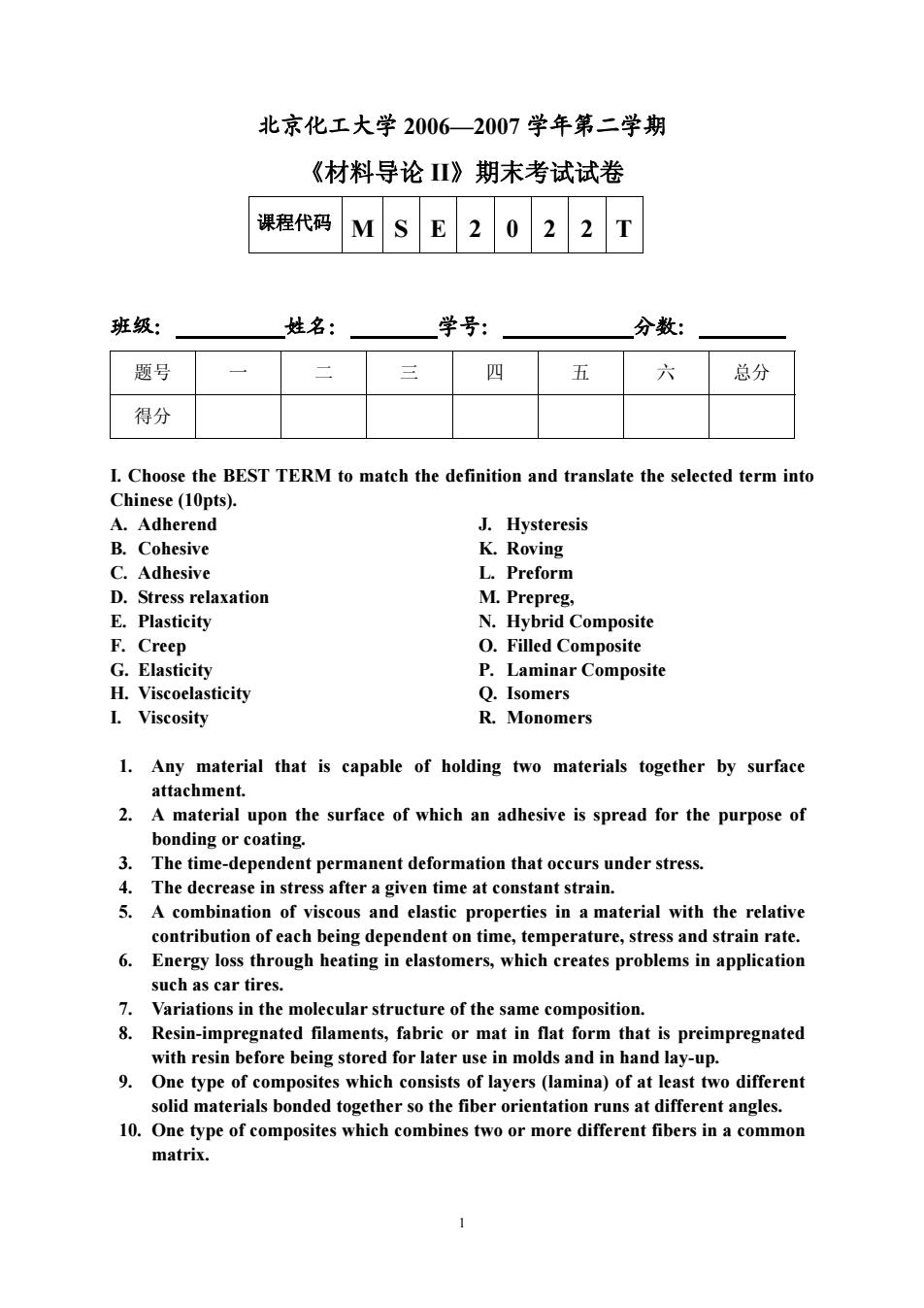
北京化工大学2006一2007学年第二学期 《材料导论Ⅱ》期末考试试卷 课程代码MSE2022T 班级: 姓名 学号: 分数: 题号 三 五 六 总分 得分 I.Choose the BEST TERM to match the definition and translate the selected term into Chinese(10pts). A.Adherend J.Hysteresis B.Cohesive K.Roving C.Adhesiv Preform D.Stress relaxation M.Prepreg, E.Plasticity N.Hybrid Composite F.Creep O.Filled Composite P.Laminar Composite H.Viscoelasticity I Viscosity &wm 1.Any material that is capable of holding two materials together by surface attachment. 2 A material upon the surface of which an adhesive is spread for the purpose of nd ng or coat 3 The time-dependent permanent deformation that occurs under stress. 4.The decrease in stress after a given time at constant strain. A combination of viscous and elastic properties in a material with the relative contribution of each being dependent on e,temperature,stress and strain rate. 6. Energy loss through heating in elastomers,which creates proble ms in application such as car tires. 1. Variations in the molecular structure of the same composition. 8.Resin-impregnated filaments,fabric or mat in flat form that is preimpregnated with resin before being stored for later use in molds and in hand lay-up. 9. which conists f layers(lamina)of at e st two diffe rent d together so the fiber orientation runs at d ifferent angles. 10.One type of composites which combines two or more different fibers in a common matrix
1 北京化工大学 2006—2007 学年第二学期 《材料导论 II》期末考试试卷 课程代码 M S E 2 0 2 2 T 班级: 姓名: 学号: 分数: 题号 一 二 三 四 五 六 总分 得分 I. Choose the BEST TERM to match the definition and translate the selected term into Chinese (10pts). A. Adherend B. Cohesive C. Adhesive D. Stress relaxation E. Plasticity F. Creep G. Elasticity H. Viscoelasticity I. Viscosity J. Hysteresis K. Roving L. Preform M. Prepreg, N. Hybrid Composite O. Filled Composite P. Laminar Composite Q. Isomers R. Monomers 1. Any material that is capable of holding two materials together by surface attachment. 2. A material upon the surface of which an adhesive is spread for the purpose of bonding or coating. 3. The time-dependent permanent deformation that occurs under stress. 4. The decrease in stress after a given time at constant strain. 5. A combination of viscous and elastic properties in a material with the relative contribution of each being dependent on time, temperature, stress and strain rate. 6. Energy loss through heating in elastomers, which creates problems in application such as car tires. 7. Variations in the molecular structure of the same composition. 8. Resin-impregnated filaments, fabric or mat in flat form that is preimpregnated with resin before being stored for later use in molds and in hand lay-up. 9. One type of composites which consists of layers (lamina) of at least two different solid materials bonded together so the fiber orientation runs at different angles. 10. One type of composites which combines two or more different fibers in a common matrix
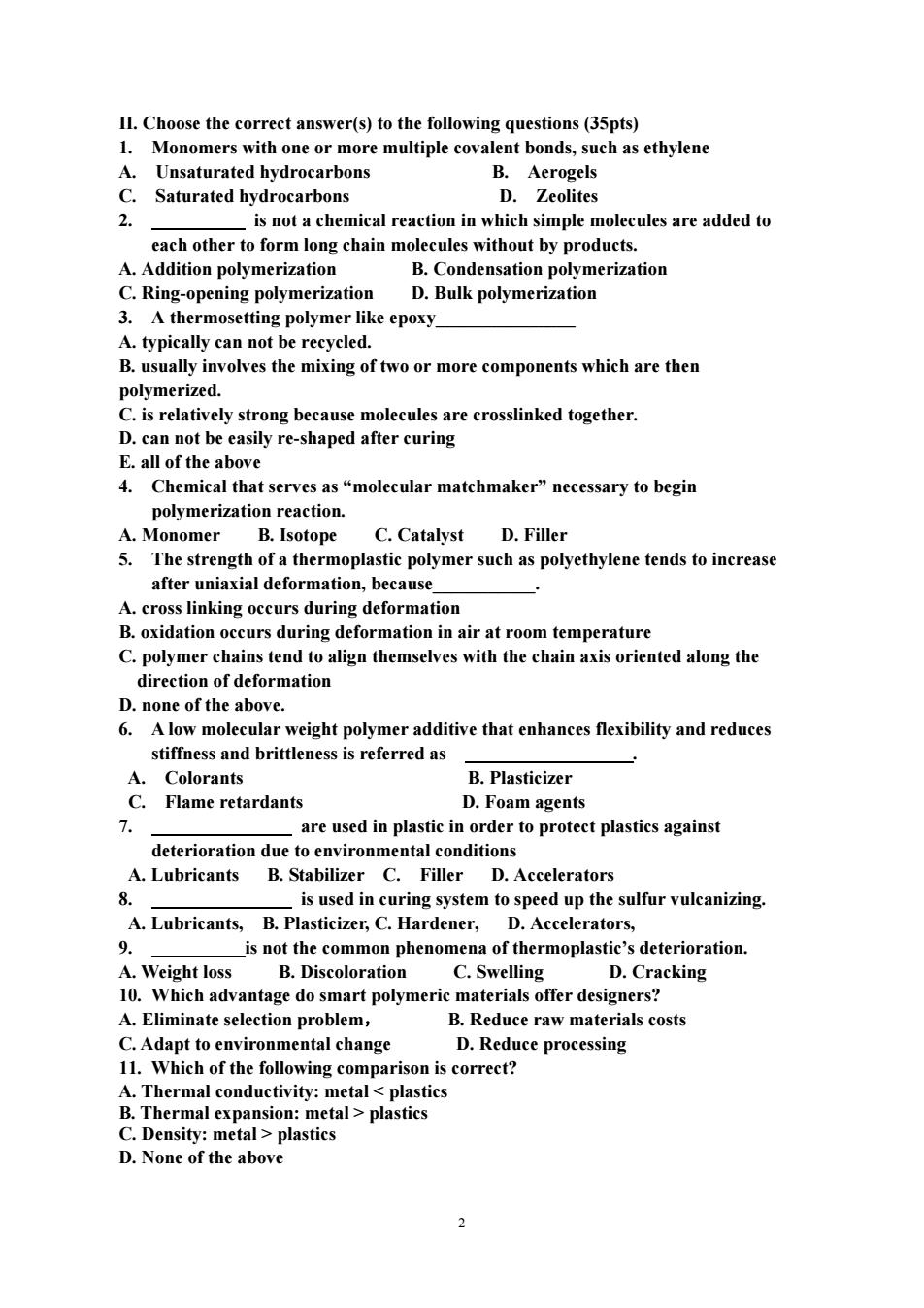
II.Choose the correct answer(s)to the following questions(35pts) 1.Monomers with one or more multiple covalent bonds,such as ethylene A.Unsaturated hydrocarbons B.Aerogels Saturated hydrocarbons ,Zeolite 2 is not a chemical reaction in which simple molecules are added to each other to form long chain molecules without by products. A.Addition polymerization B.Condensation polvmerization C.Ring-opening polymerization D.Bulk polymerization 3 A the mosetting polymer like epoxy A.typically can not be recycled B.usually involves the mixing of two or more components which are then oolymerized. C.is relatively strong because molecules are crosslinked together D.can not be easily re-shaped after curing E all of the abo 4.Chemical that serves as "molecular matchmaker"necessary to begin polymerization reaction. A.Monomer B.Isotope C.Catalyst D.Filler 5.The strength of a the noplastic polymer such as polyethylene tends to increase after axial deforma ecaus A.cros uring defomtion B.oxidation occurs during deformation in air at room temperature C.polymer chains tend to align themselves with the chain axis oriented along the direction of deformation D.none of the abo 6 A low mole ular weight polymer additive that enhances flexibility and reduces stiffness and brittleness is referred as A.Colorants B.Plasticizer Flame retardants D.Foam agents are used in plastic in order to protect plastics against deterioration due to environ ntal condition A.Lubricants B.Stabilizer C.Filler D.Accelerators is used in curing system to speed up the sulfur vulcanizing. A.Lubricants,B.Plasticizer,C.Hardener,D.Accelerators, is not the common phenomena of thermoplastic's deterioration .Weight loss B.Disco C.Swel ing D.Cr acking 10.Which advantage do smart polymeric materials offer designers? A.Eliminate selection problem, B.Reduce raw materials costs C.Adapt to environmental change D.Reduce processing 11.Which of the following comparison is correct? A.Thermal conductivity: netal plastics B.Thermal expansion: metal plastics C.Density:metal>plastics D.None of the above
2 II. Choose the correct answer(s) to the following questions (35pts) 1. Monomers with one or more multiple covalent bonds, such as ethylene A. Unsaturated hydrocarbons B. Aerogels C. Saturated hydrocarbons D. Zeolites 2. is not a chemical reaction in which simple molecules are added to each other to form long chain molecules without by products. A. Addition polymerization B. Condensation polymerization C. Ring-opening polymerization D. Bulk polymerization 3. A thermosetting polymer like epoxy_______________ A. typically can not be recycled. B. usually involves the mixing of two or more components which are then polymerized. C. is relatively strong because molecules are crosslinked together. D. can not be easily re-shaped after curing E. all of the above 4. Chemical that serves as “molecular matchmaker” necessary to begin polymerization reaction. A. Monomer B. Isotope C. Catalyst D. Filler 5. The strength of a thermoplastic polymer such as polyethylene tends to increase after uniaxial deformation, because___________. A. cross linking occurs during deformation B. oxidation occurs during deformation in air at room temperature C. polymer chains tend to align themselves with the chain axis oriented along the direction of deformation D. none of the above. 6. A low molecular weight polymer additive that enhances flexibility and reduces stiffness and brittleness is referred as . A. Colorants B. Plasticizer C. Flame retardants D. Foam agents 7. are used in plastic in order to protect plastics against deterioration due to environmental conditions A. Lubricants B. Stabilizer C. Filler D. Accelerators 8. is used in curing system to speed up the sulfur vulcanizing. A. Lubricants, B. Plasticizer, C. Hardener, D. Accelerators, 9. is not the common phenomena of thermoplastic’s deterioration. A. Weight loss B. Discoloration C. Swelling D. Cracking 10. Which advantage do smart polymeric materials offer designers? A. Eliminate selection problem, B. Reduce raw materials costs C. Adapt to environmental change D. Reduce processing 11. Which of the following comparison is correct? A. Thermal conductivity: metal plastics C. Density: metal > plastics D. None of the above
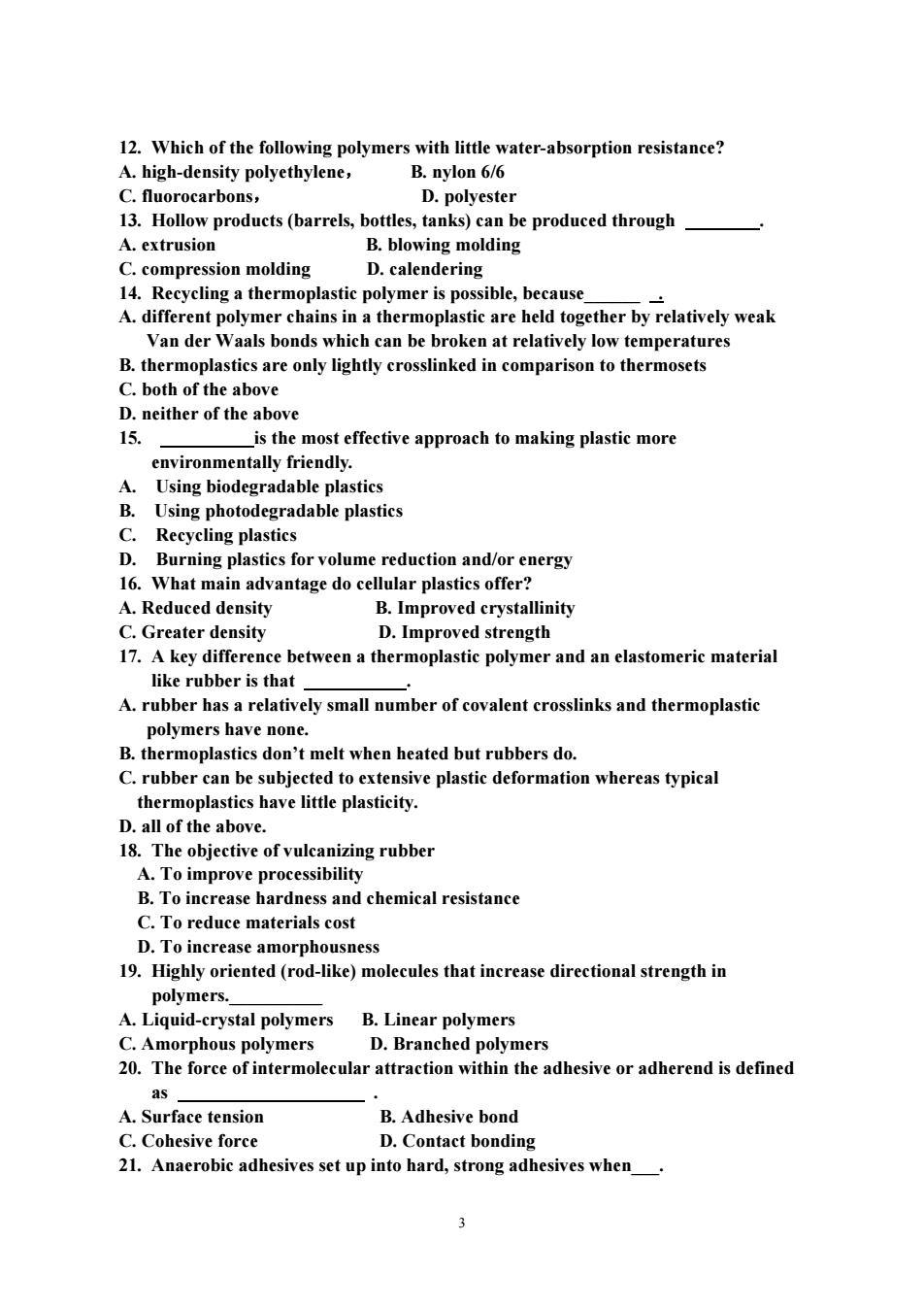
12.Which of the following polymers with little water-absorption resistance? B.nylon 66 D.polyester 13.Hollow products(barrels,bottles,tanks)can be produced through A.extrusion B.blowing molding C.compression molding D.calendering 14 Re cycling a ther plastic polymer is p ssible,because A er chains in oplastic are held together by relatively weak Van der Waals bonds which can be broken at relatively low temperatures B.thermoplastics are only lightly crosslinked in comparison to thermosets C.both of the above D.neither of the above is the most effective approach to making plastic more environmentally friendly. 4. Using biodegradable plastics B.Using photodegradable plastics C.Recycling plastics ning g plastics for volume reduction and/or nergy 16.What main ady vantage do c ar plastics offer A.Reduced density B.Improved crystallinity C.Greater densitv D.Improved strength 17.A key difference between a thermoplastic polymer and an elastomeric material like rubber is that A.rubber has a relatively small number of covalent crosslinks and thermoplasti polymers have none B.thermoplastics don't melt when heated but rubbers do. C.rubber can be subjected to extensive plastic deformation whereas typical thermoplastics have little plasticity. D.all of the above 18.The objective of vulcanizing rubber A.To improve processibility B.To increase hardness and chemical resistance C.To reduce materials cost D.To increase amorphou 19.Highly oriented(rod-like)molecules that increase directional strength in polymers A.Liquid-crystal polymers B.Linear polymers C.Amorphous polymers D.Branched polymers 20.The force of intermolecular attraction within the adhesive or adherend is defined a A.Surface tension B.Adhesive bond C.Cohesive force D.Contact bonding 21.Anaerobic adhesives set up into hard,strong adhesives when. 3
3 12. Which of the following polymers with little water-absorption resistance? A. high-density polyethylene, B. nylon 6/6 C. fluorocarbons, D. polyester 13. Hollow products (barrels, bottles, tanks) can be produced through . A. extrusion B. blowing molding C. compression molding D. calendering 14. Recycling a thermoplastic polymer is possible, because______ . A. different polymer chains in a thermoplastic are held together by relatively weak Van der Waals bonds which can be broken at relatively low temperatures B. thermoplastics are only lightly crosslinked in comparison to thermosets C. both of the above D. neither of the above 15. is the most effective approach to making plastic more environmentally friendly. A. Using biodegradable plastics B. Using photodegradable plastics C. Recycling plastics D. Burning plastics for volume reduction and/or energy 16. What main advantage do cellular plastics offer? A. Reduced density B. Improved crystallinity C. Greater density D. Improved strength 17. A key difference between a thermoplastic polymer and an elastomeric material like rubber is that . A. rubber has a relatively small number of covalent crosslinks and thermoplastic polymers have none. B. thermoplastics don’t melt when heated but rubbers do. C. rubber can be subjected to extensive plastic deformation whereas typical thermoplastics have little plasticity. D. all of the above. 18. The objective of vulcanizing rubber A. To improve processibility B. To increase hardness and chemical resistance C. To reduce materials cost D. To increase amorphousness 19. Highly oriented (rod-like) molecules that increase directional strength in polymers.__________ A. Liquid-crystal polymers B. Linear polymers C. Amorphous polymers D. Branched polymers 20. The force of intermolecular attraction within the adhesive or adherend is defined as . A. Surface tension B. Adhesive bond C. Cohesive force D. Contact bonding 21. Anaerobic adhesives set up into hard, strong adhesives when___
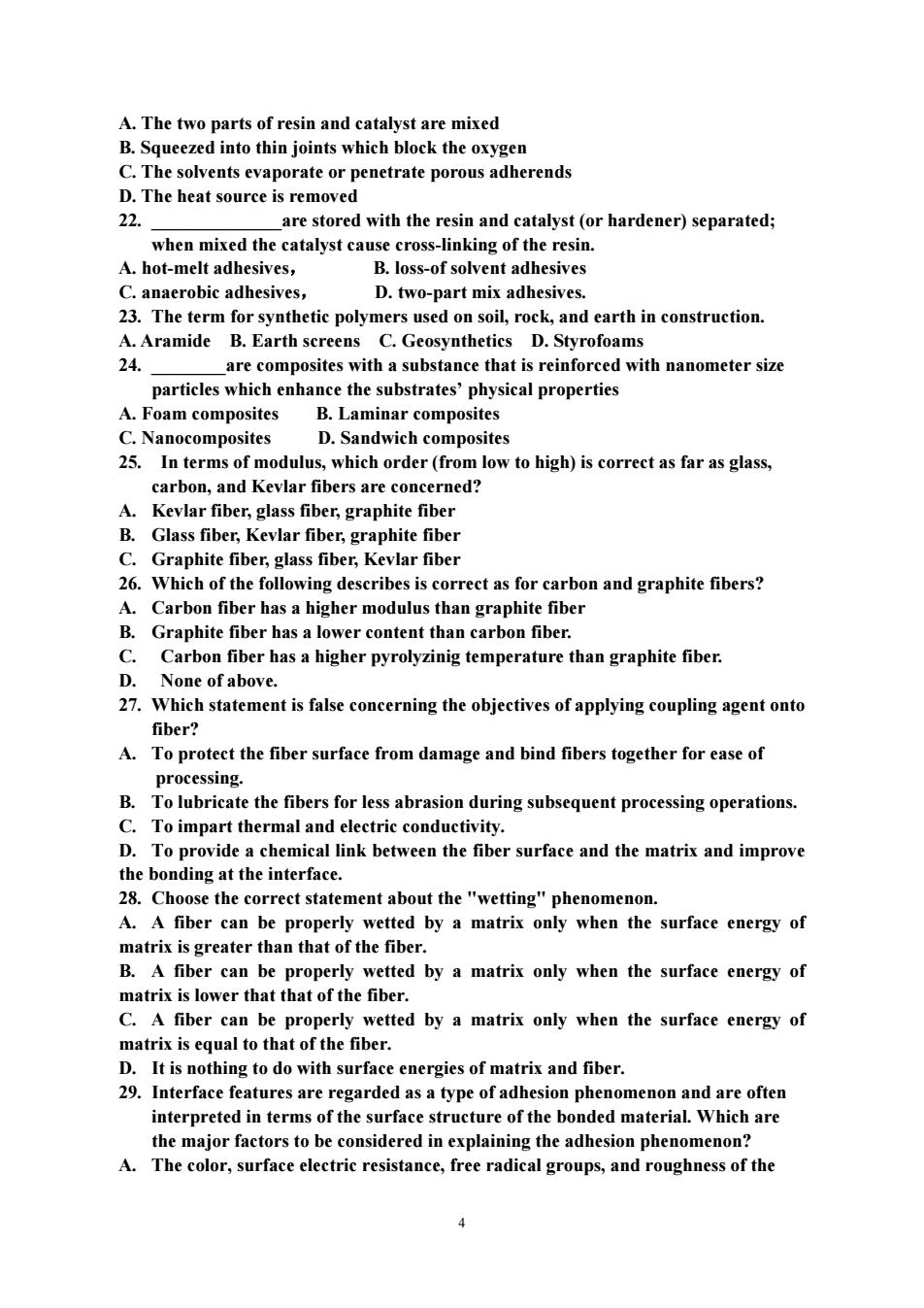
A.The two parts of resin and catalyst are mixed B.Squeezed into thin joints which block the oxygen C.The solvents evape rous adherends D.The hea source is removed 22. are stored with the resin and catalyst(or hardener)separated; when mixed the catalyst cause cross-linking of the resin. A.hot-melt adhesives, B.loss-of solvent adhesives C.anaerobic adhesives D.two-part mix adhesives used on soil,rock,and earth in construction A.Aramide B.Earth screens D.Styrofoams 24. are composites with a substance that is reinforced with nanometer size particles which enhance the substrates'physical properties A.Foam composites B.Laminar composites C.Nanocompo D.Sandwich co osites 25.In terms of modulus,which order(from low to high)is correct as far as glass, carbon,and Kevlar fibers are concerned? A.Kevlar fiber,glass fiber,graphite fiber B.Glass fiber,Kevlar fiber,graphite fiber C.Graphite fiber,glass fiber.Kevlar fiber 26.Which of the follow g describes is correet as for earbon and graphite fibers? Carbon fiber has a higher moc dulus than graphite fiber B.Graphite fiber has a lower content than carbon fiber. C.Carbon fiber has a higher pyrolyzinig temperature than graphite fiber. D.None of above. 27.Which statement is false concerning the objectives of applying coupling agent ont fiber? A.To protect the fiber surface from damage and bind fibers together for ease of processing. B.To lubricate the fibers for less abrasion during subsequent processing operations. To impart the mal and electric D To provide a ch between the fiber surface and the matrix and improve the bonding at the interface. 28.Choose the correct statement about the "wetting"phenomenon. A.A fiber can be properly wetted by a matrix only when the surface energy of matrix is greater than that of the fiber. B.A fiber can be prop etted by a matrix only when the surface energy of Is lower tha t that of the fiber C.A fiber can be properly wetted by a matrix only when the surface energy of matrix is equal to that of the fiber. D.It is nothing to do with surface energies of matrix and fiber. 29.Interface features are egarded as type of adhe esion phe and are ofter interpreted in terms of the e surfac ce structure of th bor ded material.Which are the major factors to be considered in explaining the adhesion phenomenon? A.The color,surface electric resistance,free radical groups,and roughness of the
4 A. The two parts of resin and catalyst are mixed B. Squeezed into thin joints which block the oxygen C. The solvents evaporate or penetrate porous adherends D. The heat source is removed 22. ______________are stored with the resin and catalyst (or hardener) separated; when mixed the catalyst cause cross-linking of the resin. A. hot-melt adhesives, B. loss-of solvent adhesives C. anaerobic adhesives, D. two-part mix adhesives. 23. The term for synthetic polymers used on soil, rock, and earth in construction. A. Aramide B. Earth screens C. Geosynthetics D. Styrofoams 24. ________are composites with a substance that is reinforced with nanometer size particles which enhance the substrates’ physical properties A. Foam composites B. Laminar composites C. Nanocomposites D. Sandwich composites 25. In terms of modulus, which order (from low to high) is correct as far as glass, carbon, and Kevlar fibers are concerned? A. Kevlar fiber, glass fiber, graphite fiber B. Glass fiber, Kevlar fiber, graphite fiber C. Graphite fiber, glass fiber, Kevlar fiber 26. Which of the following describes is correct as for carbon and graphite fibers? A. Carbon fiber has a higher modulus than graphite fiber B. Graphite fiber has a lower content than carbon fiber. C. Carbon fiber has a higher pyrolyzinig temperature than graphite fiber. D. None of above. 27. Which statement is false concerning the objectives of applying coupling agent onto fiber? A. To protect the fiber surface from damage and bind fibers together for ease of processing. B. To lubricate the fibers for less abrasion during subsequent processing operations. C. To impart thermal and electric conductivity. D. To provide a chemical link between the fiber surface and the matrix and improve the bonding at the interface. 28. Choose the correct statement about the "wetting" phenomenon. A. A fiber can be properly wetted by a matrix only when the surface energy of matrix is greater than that of the fiber. B. A fiber can be properly wetted by a matrix only when the surface energy of matrix is lower that that of the fiber. C. A fiber can be properly wetted by a matrix only when the surface energy of matrix is equal to that of the fiber. D. It is nothing to do with surface energies of matrix and fiber. 29. Interface features are regarded as a type of adhesion phenomenon and are often interpreted in terms of the surface structure of the bonded material. Which are the major factors to be considered in explaining the adhesion phenomenon? A. The color, surface electric resistance, free radical groups, and roughness of the

material to be bonded. B.The weight,surface free energy,smell,and roughness of the material to be The wettability,surface free energy,polar groups,and roughness of the material to be bonded. D.The thickness,surface free energy,polar groups,and flatness of the material to be bonded. 30.Which statement about fiber loading is not correct? A.the amount of reinforcement in a composite materia B.is expressed in volume fraction C.a factor influencing the composite D.the strength of the composite is inversely proportional to the volume fraction of resent 31.Which feature is not associated with the compression molding technique? Producing parts with complex shapes and close tolerances; B.High part-to-part uniformity and reproducibilitv: c.Excellent control of fiber-to-resin ratios and low void content: D.Producing parts with constant cross-section shape in a continuous way 32.Directio ope rties in fiber posites are achieved mainlydue to fibe 0 entatio B.laminate plane C.interphase D.prepregs 33.Which composite fabrication technique can only use chopped fibers in their end-use products? A.Spay up, B.Filament winding. C.Resin Transfer Molding D.Pultru ion.E.Hand Layup 34.Which of the following composite fabrication techniques can only use continuous roving? A.Spay up B.Filament winding C.Resin Transfer Molding D.Hand Layup 35.In which of the following fiber orientations,a maximum of fiber loading in mposites can be achieved? A.unidirectional B.Bidirectional C.Multidirectional D.Random III.Choose a correet word or phrase according to the basic concepts and write it in the space provided.(15 pts) 1.Copolymers are classified into four subg Ds:1) 2) 3) according to the ordered degree of molecular arrangement. 2.According to mechanism the polymerization can be classified into 5) and 6) According to the matrix materials,composites are classified into 7) ;9y 4.10) is the ratio of the tensile strength of a fiber material to its weight density
5 material to be bonded. B. The weight, surface free energy, smell, and roughness of the material to be bonded. C. The wettability, surface free energy, polar groups, and roughness of the material to be bonded. D. The thickness, surface free energy, polar groups, and flatness of the material to be bonded. 30. Which statement about fiber loading is not correct? A. the amount of reinforcement in a composite material B. is expressed in volume fraction C. a factor influencing the composite D. the strength of the composite is inversely proportional to the volume fraction of fiber present 31. Which feature is not associated with the compression molding technique? A. Producing parts with complex shapes and close tolerances; B. High part-to-part uniformity and reproducibility; C. Excellent control of fiber-to-resin ratios and low void content; D. Producing parts with constant cross-section shape in a continuous way. 32. Directional properties in fiber composites are achieved mainly due to _________. A. fiber orientation B. laminate plane C. interphase D. prepregs 33. Which composite fabrication technique can only use chopped fibers in their end-use products? A. Spay up, B. Filament winding, C. Resin Transfer Molding, D. Pultrusion, E. Hand Layup 34. Which of the following composite fabrication techniques can only use continuous roving? A. Spay up B. Filament winding C. Resin Transfer Molding D. Hand Layup 35. In which of the following fiber orientations, a maximum of fiber loading in composites can be achieved? A. unidirectional B. Bidirectional C. Multidirectional D. Random III. Choose a correct word or phrase according to the basic concepts and write it in the space provided. (15 pts) 1. Copolymers are classified into four subgroups: 1) 2) , 3) , 4) according to the ordered degree of molecular arrangement. 2. According to mechanism the polymerization can be classified into 5) , and 6) . 3. According to the matrix materials, composites are classified into 7) ; 8) ; 9) . 4. 10) is the ratio of the tensile strength of a fiber material to its weight density
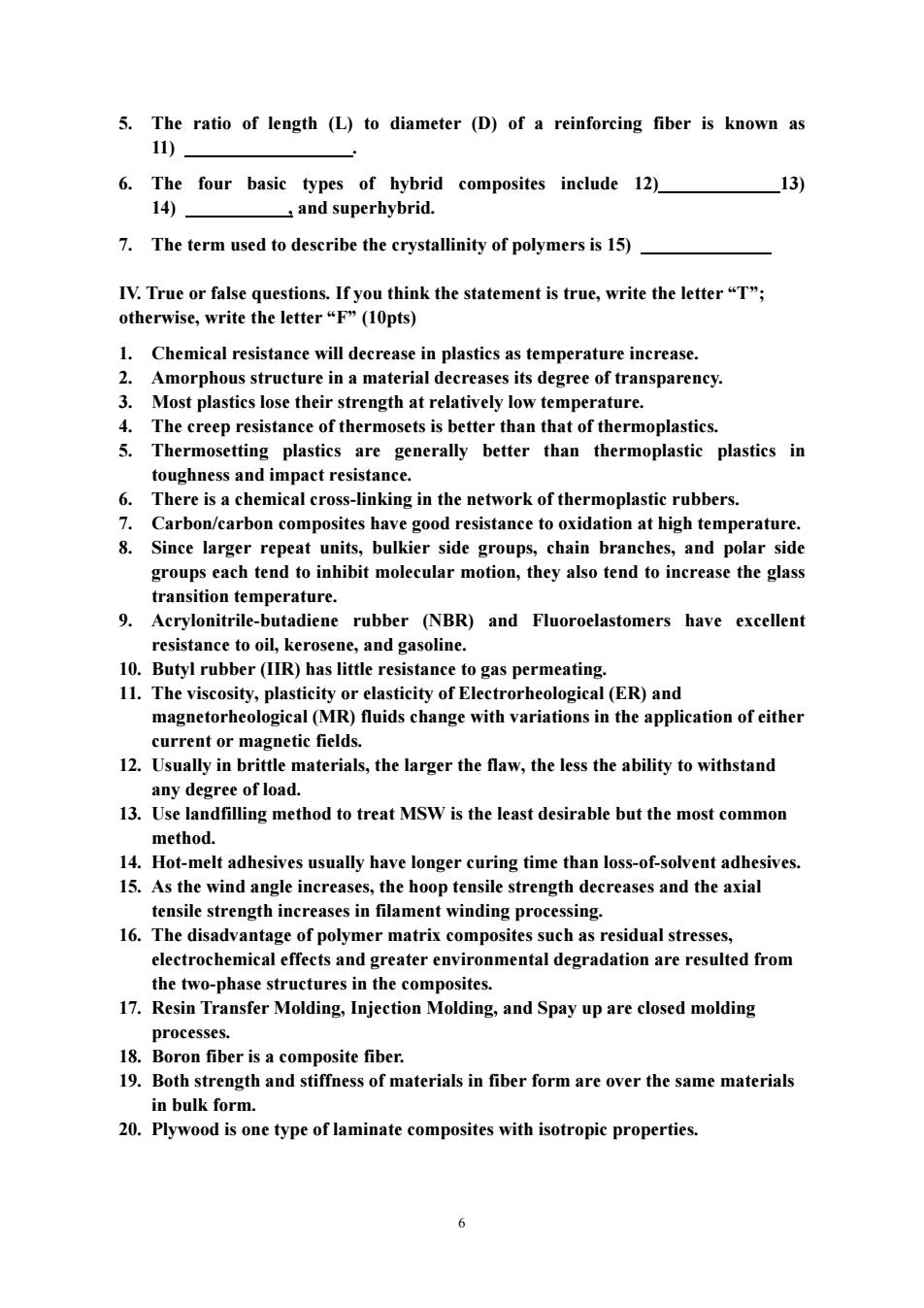
5.The ratio of length (L)to diameter (D)of a reinforcing fiber is known as 11) 6.The four basic types of hybrid composites include 12) 13) 14) and superhybrid. 7.The term used to describe the crystallinity of polymers is 15) s餐yk the statemen.write the lelter产 Chemical resistance will decrease in plastics as temperature increase. 2.Amorphous structure in a material decreases its degree of transparency. 3.Most plastics lose their strength at relatively low temperature. 4.The creep resistance of thermosets is better than that of thermoplastics 5. Thermosetting plastics are generally better than thermoplastic plastics in foughness and impact resistance. 6.There is a chemical cross-linking in the network of thermoplastic rubbers. 7.Carbon/carbon composites have good resistance to oxidation at high temperature. Since larger repeat units,bulkier side groups,chain branches,and polar side groups each tend to inhibit mole ular motion,they also tend to increase the glass transition temperature. 9.Acrylonitrile-butadiene rubber (NBR)and Fluoroelastomers have excellent resistance to oil,kerosene,and gasoline. 10.Butyl rubber (IIR)has little resistance to gas permeating. rheol gical (ER)and )fluids change with variations in the application of either current or magnetic fields. 12.Usually in brittle materials,the larger the flaw,the less the ability to withstand any degree of load. 13.Use landfilling method to treat MSW is the least desirable but the most common method. -of-solvent adhesives 15.As the wind angle increases,the hoop tensile strength decreases and the axial tensile strength increases in filament winding processing. 16.The disadvantage of polymer matrix composites such as residual stresses, electrochemical effec reater environmental degradation are resulted from the two-phase structures in the composit tes 17.Resin Transfer Molding,Injection Molding,and Spay up are closed molding processes. 18.Boron fiber is a composite fiber. 19.Both strength and stiffness of materials in fiber form are over the same materials in bulk form 20.Plywood is one type of laminate composites with isotropic properties. 6
6 5. The ratio of length (L) to diameter (D) of a reinforcing fiber is known as 11) . 6. The four basic types of hybrid composites include 12) 13) 14) , and superhybrid. 7. The term used to describe the crystallinity of polymers is 15) IV. True or false questions. If you think the statement is true, write the letter “T”; otherwise, write the letter “F” (10pts) 1. Chemical resistance will decrease in plastics as temperature increase. 2. Amorphous structure in a material decreases its degree of transparency. 3. Most plastics lose their strength at relatively low temperature. 4. The creep resistance of thermosets is better than that of thermoplastics. 5. Thermosetting plastics are generally better than thermoplastic plastics in toughness and impact resistance. 6. There is a chemical cross-linking in the network of thermoplastic rubbers. 7. Carbon/carbon composites have good resistance to oxidation at high temperature. 8. Since larger repeat units, bulkier side groups, chain branches, and polar side groups each tend to inhibit molecular motion, they also tend to increase the glass transition temperature. 9. Acrylonitrile-butadiene rubber (NBR) and Fluoroelastomers have excellent resistance to oil, kerosene, and gasoline. 10. Butyl rubber (IIR) has little resistance to gas permeating. 11. The viscosity, plasticity or elasticity of Electrorheological (ER) and magnetorheological (MR) fluids change with variations in the application of either current or magnetic fields. 12. Usually in brittle materials, the larger the flaw, the less the ability to withstand any degree of load. 13. Use landfilling method to treat MSW is the least desirable but the most common method. 14. Hot-melt adhesives usually have longer curing time than loss-of-solvent adhesives. 15. As the wind angle increases, the hoop tensile strength decreases and the axial tensile strength increases in filament winding processing. 16. The disadvantage of polymer matrix composites such as residual stresses, electrochemical effects and greater environmental degradation are resulted from the two-phase structures in the composites. 17. Resin Transfer Molding, Injection Molding, and Spay up are closed molding processes. 18. Boron fiber is a composite fiber. 19. Both strength and stiffness of materials in fiber form are over the same materials in bulk form. 20. Plywood is one type of laminate composites with isotropic properties

V.Give a simple answer to the following questions(10points) 1.(3pts)What are polymers,homopolymers and copolymers?And another name for polymer is 2.(4pts)Figure 1 is Graphical plot of the tensile modulus of a unidirectional composite material loaded under iso-strain iso-stress conditions as a function of volume fraction of reinforcing fiber. (1)Which curve is for iso-strain loading,which curve is for iso-stress loading? (2)Draw a sketch to show iso-strain loading. (3)Under iso-strain loading,the modulus of elasticity can be calculated by cquation (4)Under iso-stress loading,the modulus of elasticity can be calculated by equation voaa密 3.(3pts)Explain why carbon fiber reinforced composites are widely used in manufacturing airplane. VI.Complex questions.(20pts) 1.Predict which polymer in each pair listed can have higher degree of crystallinity, and justify your answers.(12 pts) 1 PE or Polystyr ene(PS) LDPE o or HDPE H(CHs)]or isotactic [(CH)] (6)Cooling molten PP to form solid PP under high cooling rate or under low cooling rate 2.What is a fiber-reinforced composite primary composed of?Discuss the major functions of each component in a composite?Discuss the factors which affect the properties of fiber-reinforced composites.(8)
7 V. Give a simple answer to the following questions (10points) 1. (3pts) What are polymers, homopolymers and copolymers? And another name for polymer is ? 2. (4pts) Figure 1 is Graphical plot of the tensile modulus of a unidirectional composite material loaded under iso-strain & iso-stress conditions as a function of volume fraction of reinforcing fiber. (1) Which curve is for iso-strain loading, which curve is for iso-stress loading? (2) Draw a sketch to show iso-strain loading. (3) Under iso-strain loading, the modulus of elasticity can be calculated by equation . (4) Under iso-stress loading, the modulus of elasticity can be calculated by equation . 3. (3pts) Explain why carbon fiber reinforced composites are widely used in manufacturing airplane. VI. Complex questions. (20pts) 1. Predict which polymer in each pair listed can have higher degree of crystallinity, and justify your answers. (12 pts) (1) PE or Polystyrene (PS) (2) LDPE or HDPE (3) PE or Nylon (4) Atactic [C2H3(CH3)]n or isotactic [C2H3(CH3)]n (5) isotactic (C2H3Cl)n, or isotactic [C2H3(CH3)]n (6) Cooling molten PP to form solid PP under high cooling rate or under low cooling rate 2. What is a fiber-reinforced composite primary composed of? Discuss the major functions of each component in a composite? Discuss the factors which affect the properties of fiber-reinforced composites. (8)